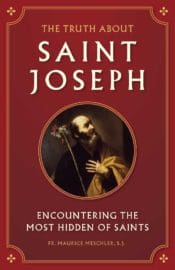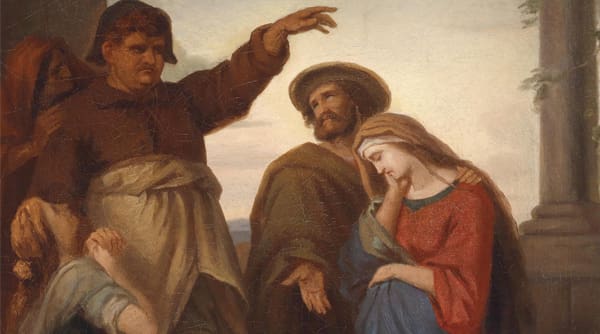The days of Mary’s expectation were gradually nearing their fulfillment. Then there went forth throughout the land a decree of the Roman emperor Augustus that all the subjected kingdoms, which included the Jewish provinces, should be enrolled together with their inhabitants. The census was carried out by Herod agreeably to the ancient custom according to tribes, houses, and families, each head of a family being obliged to return to the place of his origin for the purpose of registration.
This order was the cause of much excitement and irritation among the inhabitants. Joseph and Mary, however, submitted resignedly and patiently; for they knew that all things come from God, and that the Savior was to make His appearance in this world in Bethlehem (Mic. 5:2). And so Joseph set out for Bethlehem with Mary because she, too, as heiress had to be enrolled.
Thus, the descendants of the old Jewish families hastily traversed the various ways to their native cities, not, as may be supposed, without some show of the prestige becoming their rank and station. The season was winter; the month, December; and since at that time of the year in the Holy Land strong winds blow and heavy rains fall, it may become bitterly cold on the hills.
Mary and Joseph journeyed along slowly and modestly, recollected and patient amid the untoward treatment of men and the inclemency of the weather. Mary, heavily veiled, rode on the beast of burden that Joseph guided with the utmost solicitude.
The journey lasted about three and a half days, leading probably through the plain of Esdraelon and the green valleys of Samaria, and down from Jerusalem over the plateau of Rephaim, where of old Solomon, seated in his gilded chariot and escorted by a hundred servants, rode to the gardens of Ethan in a manner far different from that of the Holy Family. Opposite the border of the latter plateau was the small but royal city of Bethlehem, situated on an elevation of terraced gardens and vineyards and surrounded by verdant valleys where flocks of sheep and goats were wont to graze. The little town with its fortress-like dwellings covered the crest of the western ridge of the elevation, while the eastern ascent toward Jerusalem was uninhabited and contained the grotto at the very site where the cupola-crowned Church of the Nativity now stands.
It was probably at evening, just as the sun was setting, that Joseph and Mary made their uphill journey through the terraces and came to the public inn of the city. Those inns (khans) are closed spaces where travelers may procure protection, rest, and water; all other necessaries they themselves must supply. In the present instance, however, the hostelry had been completely occupied, for Bethlehem was crowded with strangers. Hence, Joseph and Mary were obliged to continue on their way, until, as is likely, after knocking at many a door and being refused admittance by the occupants, they found outside the town on the eastern hill of gray limestone a cave like shelter that served as a stable. It was probably known to Joseph or had been pointed out to him by some sympathetic person. There they settled themselves as best they could for their night’s rest.
Mary and Joseph belonged to the most illustrious families of Bethlehem; they were the holiest of the children of men, the parents of the Messiah, for whom Israel and the whole world existed; and now this Messiah was to be born far away from the great thoroughfares of the world, unknown, unacknowledged, in a strange, unimportant region, as though He were just an ordinary person. He seemed scarcely to belong to the world.
Meanwhile night stole on, and in its holy shadow the Light of the World visited this earth. We may well believe that Mary brought forth her firstborn and only Son in an ecstasy of yearning and love, and as our holy Faith teaches us, without pain or any discomfiture. She beheld Him as a poor little infant lying in the fold of her mantle. She adored Him, raised Him in her arms, and having wrapped Him in swaddling clothes, placed Him tenderly upon the soft hay of the manger, which extended along the wall.
Mary summoned Saint Joseph, who was resting close by. He approached and beheld for the first time the face of Him, to see the one who had been the desire of all creation. He gazed at the child, and supernaturally enlightened, he recognized His supreme greatness and glory in both His human and divine natures. Together with Mary he cast himself upon his knees, and before commanding Him as father, he adored Him as his God with a faith and reverence and love of which only his saintly heart was capable. Indeed, we may say his soul melted away for love and joy and gratitude to God.
All his sorrows were now forgotten in the contemplation and embrace of the divine Infant, to whom he was to be father on earth. How this child must even now have ravished his eye and captivated his heart! What a joy was his at this gift of God and of his beloved spouse, Mary, to whom this divine token bound him anew in admiration and love. Only one regret was his: the unworthy surroundings of God’s first appearance on earth and his own inability to offer Him at the present moment anything but his love and his whole heart. The impoverishment and humiliation of the royal family of David had here reached their lowest ebb.
This circumstance touched Joseph’s noble heart keenly. At that moment he realized his entire duty toward this child and made a complete sacrifice of himself to fulfill the office entrusted to him. It was his duty to support Mary in her services to the Child Jesus. Later on another Joseph (of Arimathea) would assist her in wrapping the body of her Son in the burial shroud and laying it to rest in the tomb. The swaddling bands and the manger are forerunners of the winding sheet and the grave. The divine Child saw and understood the sentiments and affections of His foster father and blessed him with marvelous graces for the fulfillment of his high vocation. By his first glimpse and embrace of the divine Babe he was clothed with an exquisite purity and wonderful sanctity.
This holy and blissful night brought Mary and Joseph a second surprise and joy. Scarcely had they offered their first homage to the Savior when the footsteps and voices of men were heard, asking for admittance into the cave. They were the holy shepherds, who, at the invitation of the angel, had come to see the Child and adore Him. They related to Saint Joseph how, while they were keeping watch over their flocks, the angel of the Lord had appeared to them and announced the birth of the divine Child. Saint Joseph listened to their story with surprise, yet with feelings of confidence and joy, and led them to the Child and His Mother. The shepherds beheld the fulfillment of all the angel had told them and, having adored the child, reverently greeted His Mother, Mary. Filled with joy and praising God for all they had seen and experienced, they returned to their flocks. They remained staunch friends of the Holy Family and announced everywhere they went the coming of the Savior.
This wonderful nocturnal visit was a source of intense joy to Saint Joseph because it was a recognition and an honoring of the divine Child and His Mother, and in his regard, a marvelous strengthening of faith, which had received its confirmation from so unexpected a circumstance. The shepherds had become an object of affection and reverence to him inasmuch as they were messengers of God upon whom a ray of the glory of His Son had rested, and who had been accounted worthy to be addressed by His holy angels and to hear their heavenly hymn of praise.
After the birth of our Savior, Saint Joseph probably sought a more suitable home for the Holy Family in Bethlehem and took up his abode there. The eighth day after Jesus’ birth brought a new honor and a mysterious lesson to the saint. The child was to be circumcised (Luke 2:21). Circumcision was a ritual law of the Old Covenant and signified the separation of Israel from all other nations, the incorporation of the circumcised into the Jewish religion, and the acceptance of its law with its promises of blessings or of curses. The child at the same time received his name and thereby obtained his full status in religious and civil society. The rite of circumcision might be performed by the father or by a priest, but to confer the name belonged by right to the father. Our Savior, although not obliged to do so, wished to submit to the law in order to give it His approval, to fulfill it, and to take upon Himself the penalties of our transgressions of the law. Such is the meaning of our Savior’s blood, shed this day for the first time. These drops of blood were a pledge that on a future day He would shed all His blood on the Cross for the redemption of the world. With awe and emotion Saint Joseph and Mary contemplated this blood offering. Did they not see in these drops of blood the threatening dawn that foreboded storm and tempest in the life of their beloved Child?
Such, too, was the meaning of the holy name of Jesus, which signifies God and Savior. It expresses, therefore, not only the essence of the God-Man, His human and divine nature, but also His mission and its effects in our regard. The holy name was to be for us a pledge of our redemption, of the forgiveness of our sins, of the hearing of our petitions, in a word, the pledge and intermediary of all blessing, all strength and consolation in life and death. For our Savior it was to be the pledge of His future exaltation, so that at His name every knee in Heaven and on earth should bow (Phil. 2:10). What our Savior is to us, that He wishes to be through the invocation of His name in the spirit of faith and love. Saint Joseph, in his capacity and with his authority of father, bestowed this name on our Savior, as he had been directed by the angel to do (Matt. 1:21). It is, therefore, manifestly befitting and proper to cherish a grateful and loving remembrance of him who gave this name to our Lord and opened to us this fountainhead of salvation.
+
This article is an excerpt from The Truth about Saint Joseph by Fr. Maurice Meschler which is available from Sophia Institute Press.
Art for this post on the journey to Bethlehem: Detail of Josef und Maria auf Herbergsuche (Joseph and Mary on hunt for hostels), Carl Rahl, 1865, PD-US author’s life plus 100 years or less, Wikimedia Commons; Cover of The Truth about Saint Joseph used with permission.





